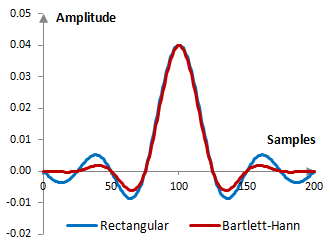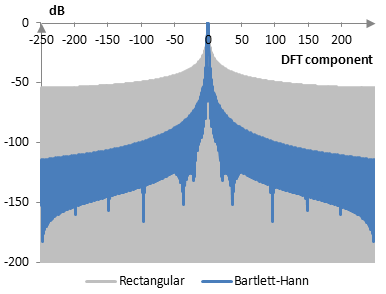The Bartlett-Hann window coefficients are given by the following formula
$$a(k)=0.62-0.48|\frac{k}{N-1}-0.5|-0.38 \, \cos(\frac{2\pi k}{N-1})$$
where N is the length of the filter and k = 0, 1, …, N – 1.
The Bartlett-Hann window is essentially the sum of a Bartlett window (a triangular window) and a Hann window.
An example Bartlett-Hann window
Consider a finite impulse response (FIR) low pass filter of length N = 201. The following is the Bartlett-Hann window.

Given a sampling frequency of 2000 Hz and a filter cutoff frequency of 40 Hz, the impulse response of the filter with a rectangular window (with no window) and with the Bartlett-Hann window is as follows.

The magnitude response of the same filter is shown on the graph below.

The stop band attenuation of a filter with the Bartlett-Hann window can be as high as -35 dB and as low as -65 dB. The ripples and transition of the Bartlett-Hann window are difficult to quantify, as the filter rarely exhibits ripples. As in the graph above, the magnitude response of the filter tends to show no ripples and to decrease monotonically from the start of the frequency spectrum to the stop band. In the rare cases, where the filter with the Bartlett-Hann window does have ripples, those are usually around +/- 0.02 dB to +/- 0.03 dB. In these cases, the relationship between the length of the filter N and the size of the transition band between 0 dB and the stop band is approximately N = 2.31 / (transition / fs), where fs is the sampling frequency.
Measures for the Bartlett-Hann window
The following is a comparison of the discrete Fourier transform of the Bartlett-Hann window and the rectangular window.

The Bartlett-Hann window measures are as follows.
| Coherent gain | 0.5 |
| Equivalent noise bandwidth | 1.46 |
| Processing gain | -1.64 dB |
| Scalloping loss | -1.51 dB |
| Worst case processing loss | -3.15 dB |
| Highest sidelobe level | -35.9 dB |
| Sidelobe falloff | -12.7 dB / octave, -42.3 dB / decade |
| Main lobe is -3 dB | 1.40 bins |
| Main lobe is -6 dB | 1.94 bins |
| Overlap correlation at 50% overlap | 0.186 |
| Amplitude flatness at 50% overlap | 1.000 |
| Overlap correlation at 75% overlap | 0.674 |
| Amplitude flatness at 75% overlap | 1.000 |
See also:
Window
Add new comment